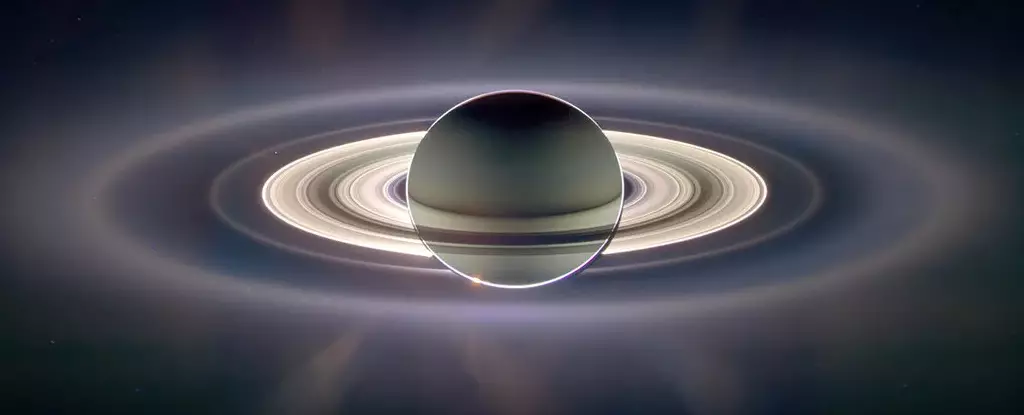Saturn, the splendid jewel of our solar system, is often recognized for its breathtaking and elaborate ring system. These rings, formed of ice and dust particles, have captivated astronomers and casual stargazers alike for centuries. However, the narrative surrounding the age of Saturn’s rings has shifted dramatically in light of new research, raising fascinating questions about their origins and longevity in the cosmos.
The arrival of the Cassini spacecraft in 2004 marked a new era in our understanding of Saturn. This groundbreaking mission unveiled the astonishing detail in the structure of Saturn’s rings, leading to an unexpected finding: the particles found within these rings exhibited an astonishing lack of dust. Traditional science suggested that such particles, constantly bombarded by micrometeoroids, should be cloaked in a layer of dust accumulated over billions of years. This led scientists to theorize that Saturn’s rings were a relatively recent phenomenon, existing for only 100 to 400 million years— a blink of the eye in cosmic terms. This possibility painted a peculiar picture of a ringless Saturn above a bustling Earth populated by dinosaurs.
Recently, a study spearheaded by researchers from the Institute of Science Tokyo and the French National Centre for Scientific Research upended this assumption, presenting a compelling argument that Saturn’s rings could be much older than previously thought. Planetary scientist Ryuki Hyodo, one of the leading voices in this research, highlights the need to reassess our interpretations of observed phenomena. The initial clean appearance of Saturn’s rings, which led to the youth hypothesis, may lead scientists to overlook more complex realities beneath the surface.
Hyodo remarked, “Data from the Cassini spacecraft suggested the rings might be young because they appear so clean… However, our theoretical work now shows that a clean appearance does not necessarily mean the rings are young.” This represents not only a shift in thinking about Saturn’s rings but also sheds light on a broader principle applicable to planetary exploration: early conclusions can often lead to misinterpretations that misrepresent the true nature of celestial bodies.
The notion that rings of ice may remain pristine over extended periods is fascinating. To unpack this, Hyodo and his team utilized theoretical modeling to simulate the reactions that occur when high-speed micrometeoroids collide with the ice-based rings. Micrometeoroids, tiny remnants of cometary debris, travel at speeds exceeding 25 kilometers per second, which, upon impact, induces temperatures hot enough to vaporize both the impacting particle and a section of the icy ring. The resultant material, instead of tainting the rings, transmutes into nanoparticles that disperse due to Saturn’s powerful magnetic field, preventing the accumulation of dust and confirming the cleanliness of the rings.
This remarkable process not only illustrates how Saturn’s rings can retain their dazzlingly bright appearance but also hints at the methods employed in the formation of other celestial structures. If the rings are indeed ancient, implications abound regarding their longevity and future decay.
Contrary to earlier beliefs suggesting that Saturn’s rings were on a fast track to decay, Hyodo’s revelations indicate that they could persist for much longer than previously estimated. Cassini’s findings indicated a phenomenon termed “ring rain,” which involved water and other materials falling from the rings to the planet below. Initially interpreted as a sign of decay, these findings could now signify a continuation of the rings’ existence rather than their decline.
This perspective also sets the stage for further investigation into the chaotic conditions of the early Solar System, where violent collisions could have produced the debris that eventually transformed into Saturn’s rings. While still hypothetical, this potential narrative tidies several unresolved questions regarding the planet’s history.
With this new theoretical understanding as a backdrop, the scientific community is spurred on to explore Saturn’s rings more comprehensively. Hyodo’s team is engaged in laboratory simulations of the micrometeoroid bombardment of icy particles and paving the way for upcoming planetary exploration missions that will delve deeper into the mysteries surrounding these celestial structures.
The quest to understand Saturn’s rings is not merely about their composition but also about how our perceptions of the universe evolve based on emerging research. The age and nature of Saturn’s rings could offer fresh insights into the past of our Solar System and potentially resonate across a broader cosmic scale, influencing our understanding of exoplanetary systems beyond our reach. This evolving narrative underscores the importance of open-mindedness in science—where initial conclusions might lead to unexpected discoveries that reframe our understanding of the universe.


Leave a Reply